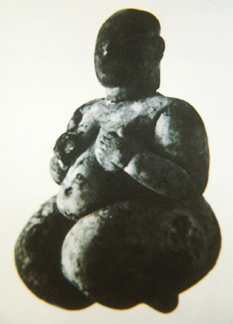
Seated female figure of fired clay, Çatal Hüyük, Turkey
5500 BCE
ART 198 - HISTORY OF WORLD CERAMICS
| This seated female figure is an example of the earliest uses of fired clay during the Neolithic. The earliest fired ceramics were not vessels, but objects made for magical or religious purposes. This effigy was found in a granary, and it is thought that its purpose was to ensure a good harvest, through sympathetic magic. Similar in many ways to the more famous 'Venus of Willendorf,' which predates this figure by over 17,000 years, this figure has exaggerated the female attributes and probably symbolized fertility. This is suggested by the observation that these figures do not have individualized features which would indicate a portrait of a specific individual, but rather the fact that the features are generic, with an emphasis on the large breasts and thighs. Found in the area of modern day Turkey, at Çatal Hüyük, it is very representative of such figures, which have been found in large numbers in sites of early agricultural communities. | Seated female figure of fired clay, Çatal Hüyük, Turkey 5500 BCE |
|
|